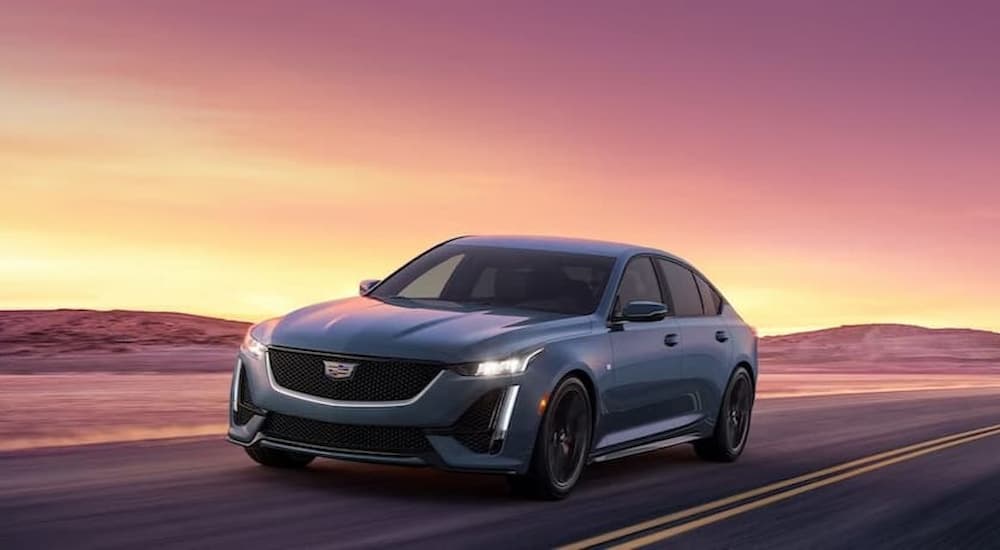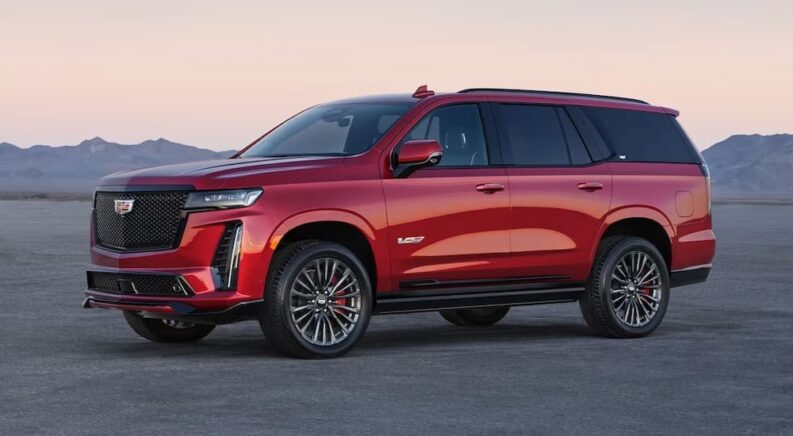As a brand that’s built its name on luxury, Cadillac never treats comfort as an afterthought. While power, style, and convenience all play a vital role in the Cadillac formula, it’s the automaker’s reputation for a smooth, refined ride that has allowed the company to dominate the American luxury market. Cadillac has emphasized comfort through innovative suspension technology for over half a decade. Introduced in 1957, the Cadillac Eldorado Brougham serves as a prime example of Cadillac’s forward-thinking approach. The Eldorado Brougham was the first American-made car to come standard with a self-leveling suspension, not to mention one of the earliest examples of a “memory seat” function. Guided by its “Art and Science” design philosophy, Cadillac has continued to create some of the most elegant vehicles on the road today, evolving with the times to offer drivers a thoroughly modern ride backed by a familiar name.
Walk into the Jim Ellis Cadillac service center near Doraville, and you’re bound to find any number of sedans, crossovers, and full-size SUVs bearing the stylized coat of arms of the brand’s namesake, Antoine de la Mothe Cadillac. Look a little closer, and you’ll find the two technologies that have allowed Cadillac to remain the go-to name in the domestic luxury market: Air Ride Adaptive Suspension and Magnetic Ride Control. While the two offerings differ in their approach, they’re both pulling for a common goal: creating a smooth, comfortable ride that drivers won’t soon forget. But Cadillac’s Air Ride Adaptive Suspension (Air Ride) and Magnetic Ride Control (also called MagneRide) are not mutually exclusive. In fact, many of Cadillac’s vehicles are offered with both Air Ride and MagneRide, allowing drivers to leverage some of the industry’s most advanced suspension technology all in one vehicle. Read on as we take a closer look at Air Ride and MagneRide, see how they differ, and, most importantly, build on Cadillac’s legacy of luxury.

Air Ride Adaptive Suspension
Cadillac’s Air Ride Adaptive Suspension employs a central air pump connected to the shock absorbers on each corner of the vehicle. When activated, this pump feeds air to each absorber, raising or lowering the ride height by as much as four inches to ensure a level ride. This description might have you picturing the bouncing, hydraulically-powered rides common to the West Coast lowrider scene, but Cadillac’s technology is decidedly more subtle in its approach and execution.
Air Ride offers a number of benefits when it comes to comfort, efficiency and convenience. Are you looking to take your Escalade to the road less traveled for a little off-road excursion? Air Ride allows drivers to maximize their ground clearance, protecting the undercarriage by elevating the vehicle above any obstacles that might stand in their way. When in 4WD HI, Air Ride allows the vehicle to rise by as much as one inch. Throw it into 4WD low, and you’ll gain an additional inch of ground clearance, allowing vehicles like the Cadillac Escalade to boldly go where many of its luxury competitors wouldn’t dare.
Of course, a higher ride isn’t always a better ride. If you want to improve your Cadillac’s fuel economy, Air Ride can help lower the vehicle by almost an inch. This might not sound like much, but it can greatly impact efficiency when it comes to highway driving. Air Ride also offers some substantial benefits when it comes to comfortably entering and exiting the vehicle. Many drivers appreciate a higher ride thanks to the increase in visibility, but it can also present some real issues when it comes to drivers of smaller stature getting in and out. With Air Ride, drivers can lower the suspension by two inches, which means no more scaling to the side of your vehicle to get into the cabin. This is an especially important feature for some of Cadillac’s taller models, like the Escalade, which measures in at over 76 inches tall.
Cadillac’s Air Ride Adaptive Suspension might sound pretty futuristic, but the technology has been around since 2013 when it debuted on the brand’s XTS sedan. Air Ride has gradually found its way into two of the brand’s flagship SUVs, the Cadillac Escalade and Escalade ESV. Air Ride is also offered on a number of models from Cadillac’s GM cousins, including the Chevy Tahoe, Suburban, GMC Yukon, and Yukon XL.
MagneRide
To understand the benefits of the MagneRide system, we first need to learn how it differs from the traditional suspension design. The term “suspension” is used to refer to a whole suite of components spread throughout the vehicle, including springs, shock absorbers or struts, linkages, bushings, bearings, joints, and even the tires and wheels themselves. While all these parts play an important role in reducing body roll and keeping your tires firmly planted on the ground, the shock absorbers and springs are usually the real workhorses as they play an outsized role in overall comfort. Shock absorbers, also called dampers, are great when it comes to absorbing impacts and controlling body roll, compressing a gas or fluid within a tube to soak up the bumps in the road. Dampers can be tuned to be softer or firmer depending on the kind of ride a driver is looking for, but most are not designed to quickly shift between the two extremes.
That’s where MagneRide comes in. Instead of the standard gas or fluid medium found in many dampers, the MagneRide system uses a magnetorheological fluid made of synthetic oil and small iron particles. This unique approach means that the viscosity of the fluid can be changed in a fraction of a second, allowing the MagneRide system to constantly and instantly adjust to changing road conditions and offer the smoothest possible ride. When cruising down a straightaway, the MagneRide system provides a smooth, cushy ride perfect for soaking up bumps, potholes, and other imperfections. That all changes when you start to go around a sharp corner. At this point, the MagneRide system kicks into action, electrically activating magnetic fields that cause the iron particles within the magnetorheological fluid to organize themselves in a dense pattern to increase stiffness and reduce body roll. This marks a drastic improvement over traditional dampers, which rely on valves that employ a slower, more mechanical approach.
Adaptive suspension systems are nothing new, but MagneRide’s pure speed sets it apart from the competition. According to Cadillac, the MagneRide system can monitor current road conditions as fast as 1,000 times per second, allowing the suspension to rapidly adjust to any changes you might encounter. That’s quick enough to earn MagneRide the distinction of being the industry’s fastest-reacting suspension system. But speed isn’t the only factor to consider when it comes to measuring MagneRide against garden-variety adaptive suspension systems. The magnetic approach to shock absorption makes MagneRide dampers less complex and prone to wear than mechanically-based systems. This can significantly reduce lifetime maintenance and repair costs, making MagneRide an important addition to any Cadillac model.
MagneRide has graced a number of GM vehicles since it was first introduced on the 2002 Cadillac Seville. The system’s comfort-enhancing properties are a boon to any ride, from larger models like the Cadillac Escalade and Chevy Tahoe to full-size sedans like the Cadillac CT5 and even legendary muscle and sports cars like the Chevy Camaro and Corvette. As far as Cadillac is concerned, MagneRide is now offered on five of the luxury brand’s most popular models, including the ATS, CTS, XTS, CT6, and Escalade.

Comfort is King at Cadillac
With over a century of success to its name, Cadillac knows a thing or two about producing a comfortable ride. While many drivers and critics like to measure a luxury vehicle by its interior flourishes, high-tech gadgets, and other bells and whistles, Cadillac has never lost sight of comfort’s role in the overall driving experience. Whether this comfort comes in the form of best-in-class headroom and legroom, as one will find in the CT6 or CT6-V, or the smooth ride provided by technologies like Air Ride Adaptive Suspension and Magnetic Ride Control, it enables Cadillac to remain at the forefront of the luxury conversation. Consumer Reports lauded the CT6 in its review of luxury sedans, with particular attention heaped on the model’s smooth ride, providing “a layer of plushness that masks all types of road imperfections.” Air Ride Adaptive Suspension and Magnetic Ride Control might not be the only advanced suspension systems on the market, but when paired with Cadillac’s considerable experience in the segment, they give the automaker a major advantage over many of its rivals.

